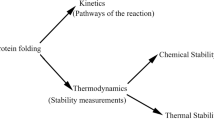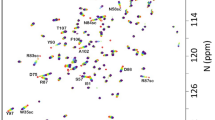Abstract
HETex-SOFAST NMR (Schanda et al. in J Biomol NMR 33:199–211, 2006) has been proposed some years ago as a fast and sensitive method for semi-quantitative measurement of site-specific amide-water hydrogen exchange effects along the backbone of proteins. Here we extend this concept to BEST readout sequences that provide a better resolution at the expense of some loss in sensitivity. We discuss the theoretical background and implementation of the experiment, and demonstrate its performance for an intrinsically disordered protein, 2 well folded globular proteins, and a transiently populated folding intermediate state. We also provide a critical evaluation of the level of accuracy that can be obtained when extracting quantitative exchange rates from HETex NMR measurements.




Similar content being viewed by others
References
Chevelkov V, Xue Y, Rao DK, Forman-Kay JD, Skrynnikov NR (2010) 15 N H/D-SOLEXSY experiment for accurate measurement of amide solvent exchange rates: application to denatured drkN SH3. J Biomol NMR 46:227–244
Croke RL, Sallum CO, Watson E, Watt ED, Alexandrescu AT (2008) Hydrogen exchange of monomeric alpha-synuclein shows unfolded structure persists at physiological temperature and is independent of molecular crowding in Escherichia coli. Protein Sci 17:1434–1445
Crowhurst KA, Tollinger M, Forman-Kay JD (2002) Cooperative Interactions and a Non-native Buried Trp in the Unfolded State of an SH3 Domain. J Mol Biol 322:163–178
Csizmok V, Felli IC, Tompa P, Banci L, Bertini I (2008) Structural and dynamic characterization of intrinsically disordered human securin by NMR spectroscopy. J Am Chem Soc 130:16873–16879
Dempsey CE (2001) Hydrogen exchange in peptides and proteins using NMR spectroscopy. Prog in NMR Spectrosc 39:135–170
Englander SW, Kallenbach NR (1983) Hydrogen exchange and structural dynamics of proteins and nucleic acids. Q Rev Biophys 16:521–655
Fan J-S, Lim J, Yu B, Yang D (2011) Measurement of amide hydrogen exchange rates with the use of radiation damping. J Biomol NMR 51:151–162
Favier A, Brutscher B (2011) Recovering lost magnetization: polarization enhancement in biomolecular NMR. J Biomol NMR 49:9–15
Fitzkee NC, Da Torchia, Bax A (2011) Measuring rapid hydrogen exchange in the homodimeric 36 kDa HIV-1 integrase catalytic core domain. Protein Sci 20:500–512
Gal M, Schanda P, Brutscher B, Frydman L (2007) UltraSOFAST HMQC NMR and the repetitive acquisition of 2D protein spectra at Hz rates. J Am Chem Soc 129:1372–1377
Geen H, Freeman R (1991) Band-selective radiofrequency pulses. J Magn Reson 93:93–141
Gemmecker G, Jahnke W, Kessler H (1993) Measurement of fast proton exchange rates in isotopically labeled compounds. J Am Chem Soc 115:11620–11621
Gil S, Hošek T, Solyom Z, Kümmerle R, Brutscher B, Pierattelli R, Felli IC (2013) NMR Spectroscopic Studies of Intrinsically Disordered Proteins at Near-Physiological Conditions. Angew Chem Int Ed Engl 52:11808-11812
Grzesiek S, Bax A (1993) Measurement of amide proton-exchange rates and Noes with Water in C-13/N-15-Enriched Calcineurin-B. J Biomol NMR 3:627–638
Hwang TL, van Zijl PC, Mori S (1998) Accurate quantitation of water-amide proton exchange rates using the phase-modulated CLEAN chemical EXchange (CLEANEX-PM) approach with a Fast-HSQC (FHSQC) detection scheme. J Biomol NMR 11:221–226
Kameda A, Hoshino M, Higurashi T, Takahashi S, Naiki H, Goto Y (2005) Nuclear magnetic resonance characterization of the refolding intermediate of beta(2)-microglobulin trapped by non-native prolyl peptide bond. J Mol Biol 348:383–397
Krishnan VV, Murali N (2013) Radiation damping in modern NMR experiments: progress and challenges. Prog in NMR Spectrosc 68:41–57
Kupce E, Freeman R (1994) Wide-Band Excitation with Polychromatic Pulses. J Magn Reson A 108:268–273
Kupce E, Boyd J, Campbell ID (1995) Short selective pulses for biochemical applications. J Magn Reson B 106:300–303
Lescop E, Schanda P, Brutscher B (2007) A set of BEST triple-resonance experiments for time-optimized protein resonance assignment. J Magn Reson 187:163–169
Mori S, O’Neil Johnson M, Berg JM, Van Zijl PCM (1994) Water exchange filter (WEX Filter) for nuclear magnetic resonance studies of macromolecules. J Am Chem Soc 116:11982–11984
Rennella E, Cutuil T, Schanda P, Ayala I, Forge V, Brutscher B (2012) Real-time NMR characterization of structure and dynamics in a transiently populated protein folding intermediate. J Am Chem Soc 134:8066–8069
Rennella E et al (2013) Oligomeric states along the folding pathways of β2-microglobulin: kinetics, thermodynamics, and structure. J Mol Biol 425:2722–2736
Schanda P, Brutscher B (2005) Very fast two-dimensional NMR spectroscopy for real-time investigation of dynamic events in proteins on the time scale of seconds. J Am Chem Soc 127:8014–8015
Schanda P, Kupce E, Brutscher B (2005) SOFAST-HMQC experiments for recording two-dimensional heteronuclear correlation spectra of proteins within a few seconds. J Biomol NMR 33:199–211
Schanda P, Forge V, Brutscher B (2006) HET-SOFAST NMR for fast detection of structural compactness and heterogeneity along polypeptide chains. Magn Reson Chem 44:S177–S184
Schanda P, Forge V, Brutscher B (2007) Protein folding and unfolding studied at atomic resolution by fast two-dimensional NMR spectroscopy. Proc Natl Acad Sci USA 104:11257–11262
Segawa T, Kateb F, Duma L, Bodenhausen G, Pelupessy P (2008) Exchange rate constants of invisible protons in proteins determined by NMR spectroscopy. ChemBioChem 9:537–542
Shishmarev D, Otting G (2011) Radiation damping on cryoprobes. J Magn Reson 213:76–81
Smith AE, Sarkar M, Young GB, Pielak GJ (2013) Amide proton exchange of a dynamic loop in cell extracts. Protein Sci 22:1313–1319
Wagner G, Wüthrich K (1982) Amide Proton Exchange and Surface Conformation Basic Pancreatic Trypsin Inhibitor in Solution. J Mol Biol 160:343–361
Wider G, Riek R, Wüthrich K (1996) Diffusion filters for separation of solvent—protein and protein–protein nuclear overhauser effects (HYDRA). J Am Chem Soc 7863:11629–11634
Yao S, Hinds MG, Murphy JM, Norton RS (2011) Exchange enhanced sensitivity gain for solvent-exchangeable protons in 2D 1H-15 N heteronuclear correlation spectra acquired with band-selective pulses. J Magn Reson 211:243–247
Acknowledgments
We thank Isabel Ayala and Karine Giandoreggio for expert protein sample preparation, and we acknowledge support from ANR grant Blanc-InterII-SIMI7-2011 (RNAfolding). This work used the NMR and isotope labeling platforms of the Grenoble Instruct centre (ISBG; UMS 3518 CNRS-CEA-UJF-EMBL) with support from FRISBI (ANR-10-INSB-05-02) and GRAL (ANR-10-LABX-49-01) within the Grenoble Partnership for Structural Biology (PSB).
Author information
Authors and Affiliations
Corresponding author
Electronic supplementary material
Below is the link to the electronic supplementary material.
Rights and permissions
About this article
Cite this article
Rennella, E., Solyom, Z. & Brutscher, B. Measuring hydrogen exchange in proteins by selective water saturation in 1H–15N SOFAST/BEST-type experiments: advantages and limitations. J Biomol NMR 60, 99–107 (2014). https://doi.org/10.1007/s10858-014-9857-8
Received:
Accepted:
Published:
Issue Date:
DOI: https://doi.org/10.1007/s10858-014-9857-8




